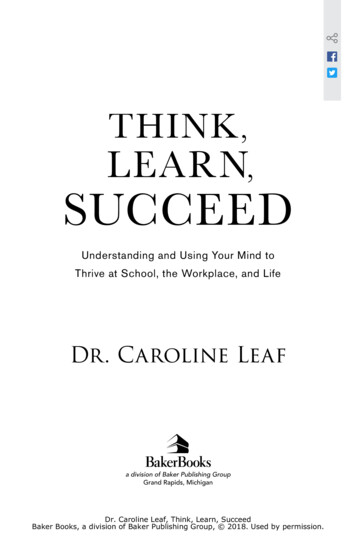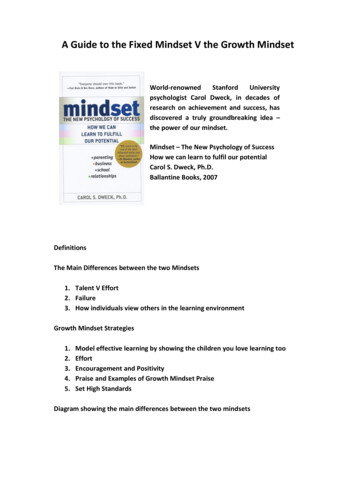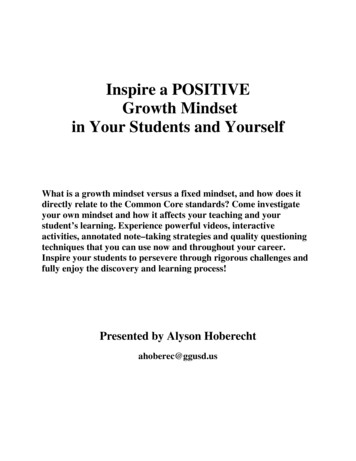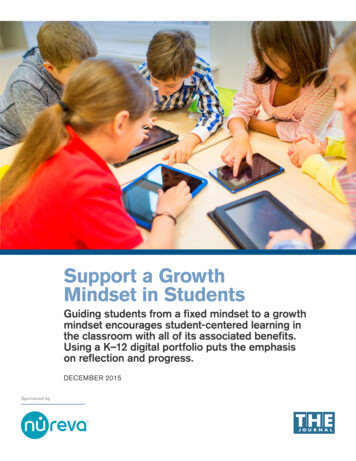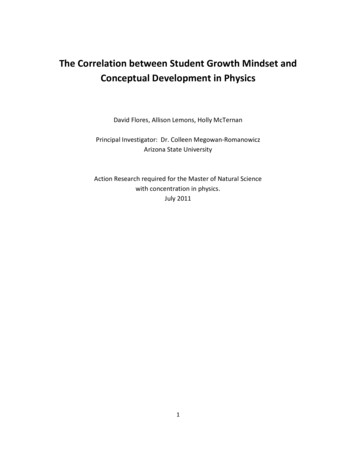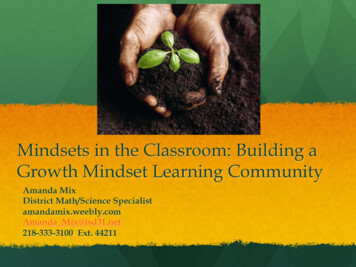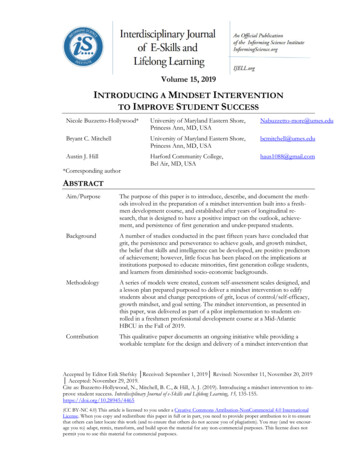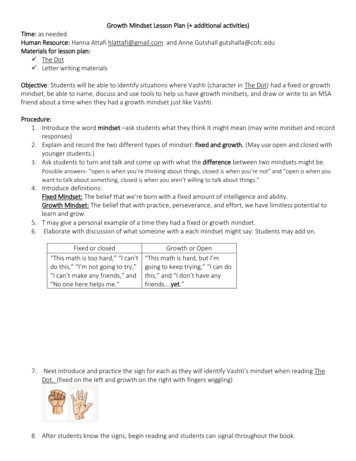
Transcription
Growth Mindset Lesson Plan ( additional activities)Time: as neededHuman Resource: Hanna Attafi hlattafi@gmail.com and Anne Gutshall gutshalla@cofc.eduMaterials for lesson plan: The Dot Letter writing materialsObjective: Students will be able to identify situations where Vashti (character in The Dot) had a fixed or growthmindset, be able to name, discuss and use tools to help us have growth mindsets, and draw or write to an MSAfriend about a time when they had a growth mindset just like Vashti.Procedure:1. Introduce the word mindset –ask students what they think It might mean (may write mindset and recordresponses)2. Explain and record the two different types of mindset: fixed and growth. (May use open and closed withyounger students.)3. Ask students to turn and talk and come up with what the difference between two mindsets might be.Possible answers- “open is when you’re thinking about things, closed is when you’re not” and “open is when youwant to talk about something, closed is when you aren’t willing to talk about things.”4. Introduce definitions:Fixed Mindset: The belief that we’re born with a fixed amount of intelligence and ability.Growth Mindset: The belief that with practice, perseverance, and effort, we have limitless potential tolearn and grow.5. T may give a personal example of a time they had a fixed or growth mindset.6. Elaborate with discussion of what someone with a each mindset might say: Students may add on.Fixed or closed“This math is too hard,” “I can’tdo this,” “I’m not going to try,”“I can’t make any friends,” and“No one here helps me.”Growth or Open“This math is hard, but I’mgoing to keep trying,” “I can dothis,” and “I don’t have anyfriends .yet.”7. Next introduce and practice the sign for each as they will identify Vashti’s mindset when reading TheDot. (fixed on the left and growth on the right with fingers wiggling)8. After students know the signs, begin reading and students can signal throughout the book.
9. Guiding questions as you read:a. What is Vashti like at the beginning of the book? What is her mindset and why?b. How is Vashti changing and why?c.What tools is she using to change?d. How is she different at the end of the book than at the beginning?e. What kind of mindset does she have in the end?f.What do you think the little boy will do? What is his mindset?g. (Upper grades—tie back to neuroplasticity** If Vashti and the little boy had known about how their brains arefantastic and elastic (as you now know!) how would the story have been different?10. Ask students if there was a time that they ever felt like Vashti? What happened, what did they do?11. Discuss different tools that they can use to keep a growth mindset:12. Lesson Activity: Letter Writing and Exchange for MSA BrainbuildersK-K: Draw picture and one supporting sentence to you K friends about atime when something was difficult for you but you used a growthmindset strategy to persist!1st-5th: Write a letter to anther MSA friend about a time when somethingwas difficult for you but you used a growth mindset strategyto persist!*We would like to post photos of some letters on the wiki 3rd5th
EXCHANGE!Conclusion:As classes exchange letters, take time to read them and keep growth mindset alive in the classroom!According to previous research, letter writing and exchanging is a powerful tool to instill growth mindsetstrategies when kids share and hear from other kids!Optional Extension Activities:Activity 1: Teaching Kids to Struggle Paper -to-struggle-growthmindset/Activity 2: Growth vs. Fixed Mindset Poster or Bulletin Board (KahnAcademy)Using your students’ input, make a two-column poster on the beliefsand behaviors of a growth mindset and how it compares to a fixedmindset.Urge students to map out how beliefs influence behaviors whichultimately lead to results. If they need scenarios to help thembrainstorm, use the examples below or create your own!What are the behaviors/thoughts of people that believe intelligencecan be developed when: .they put a lot of effort into practicing for a basketball game butstill lose? .they don’t understand what they are learning in math class? .they are not putting any effort into a project but got an A anyway?Use this as a reference throughout the year to help students recognize when they have a fixed mindset and togive them ideas on methods to shift towards a growth mindset. Here’s an example of what this poster mightlook like.
Activity 3: Power of Yethttps://www.youtube.com/watch?v XLeUvZvuvAsShow video and discuss the power of yet! Make a class chart ofthings everyone can’t do YET! May tie in Vashti from The Dotagain (like example chart.)
friend about a time when they had a growth mindset just like Vashti. Procedure: 1. Introduce the word mindset -ask students what they think It might mean (may write mindset and record responses) 2. Explain and record the two different types of mindset: fixed and growth. (May use open and closed with younger students.) 3.

